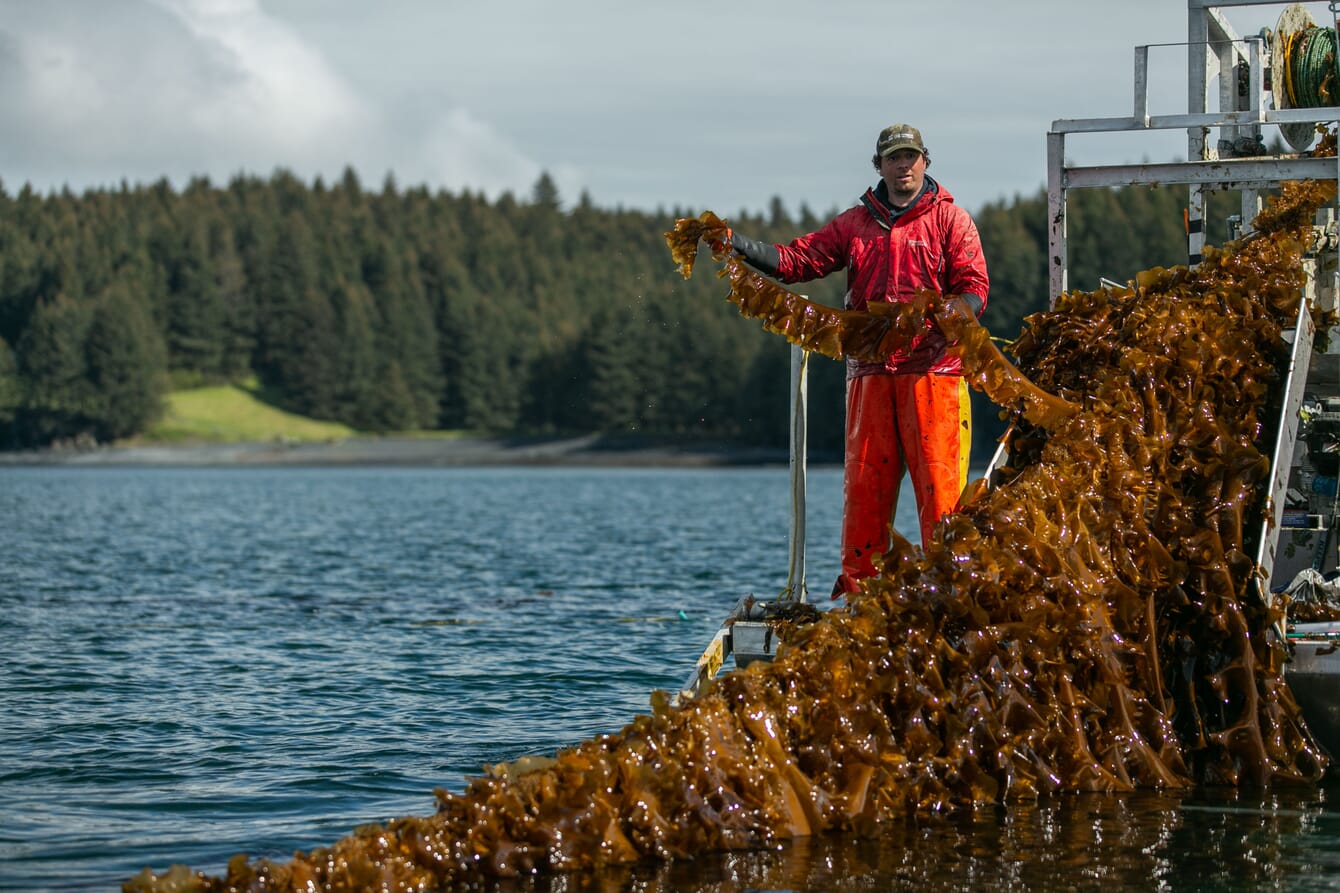
© Nicholas Mangini
The cold waters around Kodiak Island, on the eastern bend of the Gulf of Alaska, have been a source of sea riches for far-away customers for centuries. However, past overharvesting, climate change and changing markets have led to a decline in fisheries.
In response, two pioneering kelp farms have been putting down the foundations for a mariculture industry which they hope will bring back jobs, keep their communities thriving and potentially give back to the fisheries that remain the backbone of the island’s economy.
Since 2016, Nick Mangini has been running Kodiak Island Sustainable Seaweed (KISS Kelp) which makes him the most experienced seaweed farmer in the state.
As a former salmon fisher and a Kodiak native, he was looking for ways to build new economic drivers on the island.
“I see an idle harbour right now. There is a lot of downtime in May between fishing seasons, not just the boats but the workforce as well. Our canneries have an entire month where they don't have anything to do, and they are sending their workforce home, which costs them a lot of money. Thinking about how to fill that gap, that is how I got started,” he recalls.
Alf Pryor and Lexa Meyer of Alaska Ocean Farms are Kodiak’s other kelp pioneers, with seven harvests under their belt. For Pryor, kelp farming was a natural transition.
“I've been salmon fishing my entire life, set netting, so I had a lot of experience setting anchors and building sets. And that's kind of exactly what kelp farming is. So my skill set translated really well - it was a natural step to take,” he reflects.
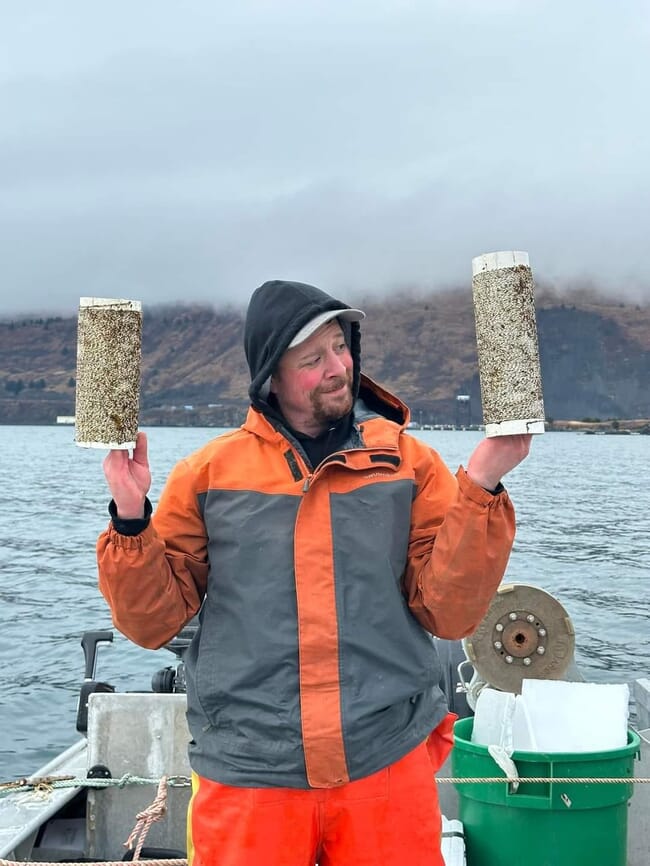
Nicholas Mangini with dragon kelp seeded rope © Nicholas Mangini
Both farms have the capacity to grow millions of pounds of kelp, but they are being held back by a lack of demand for their crops.
Is that demand going to come soon? Mangini thinks it has potential.
“We have everything that we need right here at our fingertips. Upwelling through the Gulf of Alaska brings nutrients to make the seaweed grow really well. We have been the second largest seafood producing port in the United States for a number of years running, with the largest crane in Alaska. We have a lot of really skilled workers and fairly cheap electricity as far as Alaska goes, with 99 percent renewables from a hydroelectric dam and six windmills,” he observes.
Pryor and Meyer agree, but know it’s not going to be easy.
“Sometimes it feels like it’s almost there, and sometimes it feels like it isn't. We do think people are going to catch on that we are capable of growing biomass at scale reliably. We have a really solid foundation, a lot of people rooting for us. We think we'll get there. But maybe not as fast as everybody thought at first,” they explain.
“That's why we're looking at diversifying into shellfish, to have more of that steady work throughout the year because kelp does have a very short season. Expanding that season is really important. That'll help keep good people longer and give them more work,” they add.
Seeding diversity to let native species shine
KISS Kelp had a world premiere this year: putting the first lines of farmed dragon kelp in the water.
An Mangini explains: “I grow sugar kelp and ribbon kelp predominantly, but only because those are pretty easily done in the hatchery. There's been a really hard drive towards sugar kelp and ribbon kelp. But we are just starting to understand which applications are best for which species; maybe one produces better alginates for makeup, while another is just a great biomass for volume. Alaska is blessed with a lot of seaweeds that only grow here, so I really hope that we will start to focus on those.”
Alaska Ocean Farms will also be growing dragon kelp next year, as well as split kelp (Saccharina groenlandica). Three-ribbed kelp (Cymathere triplicata) and five-ribbed kelp (Costaria costata) are also being considered.
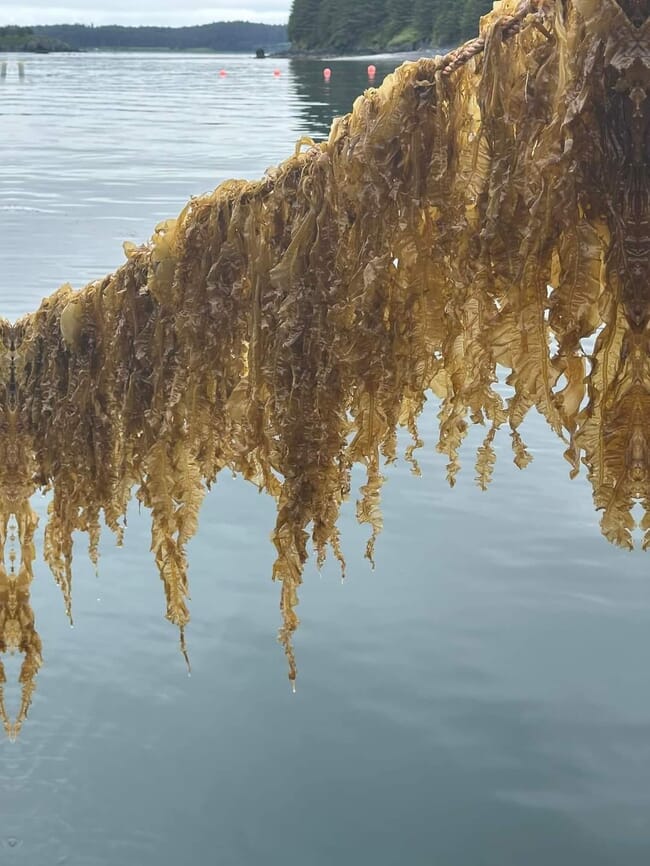
© Nicholas Mangini
Pryor is particularly excited about the potential for bull kelp (Nereocystis luetkeana).
”Bull kelp is quite special. It’s unique to the Northwest. It's very tasty, Barnacle Seafoods has demonstrated that. And it's a very fast growing kelp. High yields are always attractive to a farmer, but it potentially also makes it a good base for a biostimulant. It requires a different type of farm engineering to counteract the buoyancy, though. We are still trying to figure out how to do that without adding too much extra cost,” he explains.
Alex Lefarrier, supervisory research ecologist at the NOAA Kodiak Lab, researches seaweed and oyster farming. She echoes the challenges around flotation: “There is nowhere really in the world to look when it comes to growing bull kelp. The Australians grow Durvillea really well, but it requires a different system compared to our Nereocystis.”
She also has concerns about seed supply.
“One thing that I don't think we talk about a lot is getting seed around the state. It's a lot easier in Washington or Maine: you can just drive it somewhere. But if you're trying to get seed from Kodiak to Cordova, it's really hard to do that in 24 hours, it's almost impossible. Or even just trying to get seed out to the other side of the island,” she observes.
Meyer agrees and has set up her own hatchery to supply seed for her farm as well as others in the Kodiak region.
“We should have more hatcheries throughout Alaska. My hatchery design could be set up fairly easily in many places, I'll help them get started for free as well. The bottleneck is not funding or equipment. We are labour limited in our rural communities in Alaska and finding people that find it interesting and will stick with it for a number of years can be difficult. This is seasonal work. So what does that person do for the other six months out of the year?”
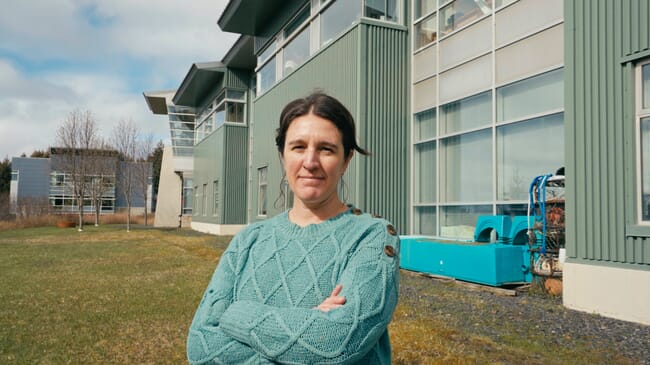
Connecting the dots, affordably
How to stabilise and process cultivated kelp at scale is an engineering challenge that has dogged the Western seaweed farming community since inception. In Alaska, too, it remains an unanswered question.
Meyer, however, points to a possible breakthrough.
“A processing demonstration will take place in Kodiak soon to potentially stabilise the kelp under ambient conditions for 6-12 months. This could be a great way to start. No more extensive processing like blanching and freezing or drying: we could just take wet kelp from the ocean, macerate it, inoculate it, and it can sit in a warehouse until we are ready for it,” she reflects.
Toby Shepherd Block, director of infrastructure at Greenwave, is also thinking hard about this question.
“Specifications from buyers are evolving as the market develops. But whether you're ensiling it, fermenting it, stabilising it with a reagent, drying it, freezing it, you've got to first break down the seaweed into smaller pieces so you have a higher surface to edge ratio. Kelp out of the water can be 15 feet long, and that's just too unwieldy for almost every stabilisation method available,” he points out.
Most seaweed farmers are not big corporations with big cap stacks. So we're looking at solutions that a small family farm or a cooperative could buy without getting an investor, without taking on debt, that will allow them to capture more of the value that they're creating. Finding disaggregated, replicable, affordable and easily repairable solutions is really critical for us,” he continues.
“Kelps are often elastic, which makes them difficult to slice, while the diatoms and ciliates on the surface are hard, dulling blades very quickly. So we like machines that crush or bash or shred rather than slice or cut. The machine we are piloting right now is really compact and runs in a variety of power systems using a square bar, so there's nothing to dull, sharpen or break. In a mechanised line you could probably get upwards of 20,000 pounds a day through this machine. The manufacturer actually offers a rental programme as well. So you can make sure that it quits your needs before you invest,” he adds.
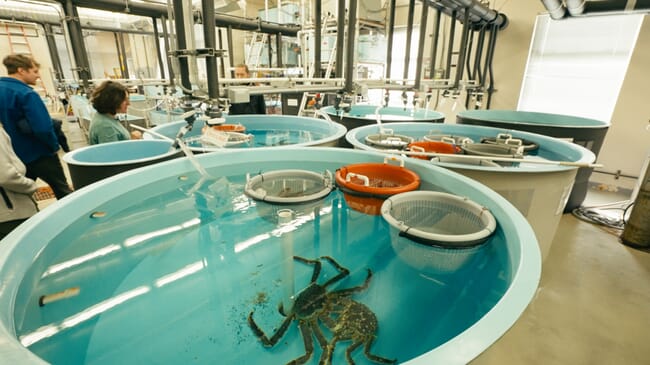
Pending the arrival of new ideas, Kodiak Wild Source, a local seafood processor, is already filling the gap. As manager, Darren Rudger, explains: “We’ve been processing local seaweeds for a few years now, and we are going to be able to dry them soon. There's a big conveyor dryer in town. It's in storage at the moment, but we're trying to make space here to start using it next year. April and May are somewhat slow and so we appreciate the seaweed to fill in the gaps and keep our employees busy.”
Lefarrier, meanwhile, is taking a different approach to extend kelp’s availability.
“We're really interested in multiple outplantings and multiple harvests. There are a lot of basic ecological questions that we still need to ask, but growing bull kelp in September for instance, could extend the season and alleviate processing bottlenecks,” she observes.
Can the kelp help?
Kodiak’s seaweed farmers are positive about the habitat their farms are creating for local fish.
As Mangini notes: “We're seeing baby fish out there living in this stuff. It's fairly hard to catch a lot of shrimp around Kodiak, but we catch them all the time in here.”
Pryor agrees: ”When we first started seven years ago there was definitely pushback [from fishermen]. Now those same guys that were a little sceptical before are coming back and saying ‘wow, I can catch fish right next to your farm.’ I think the ecosystem benefits are real. But they are hard to document.”
This is precisely what Lefarrier is trying to do: she has set up a study to understand if Kodiak’s kelp farms provide habitat that's similar to natural kelp beds over time, and what happens after harvest.
“We are trying to document and quantify the anecdotal evidence from the farmers. There is a huge lack of data from temperate systems in the literature. We haven't seen a lot yet, but we hope to build data around the synergies of cultivated kelp and wild stocks. Salmon is pretty near and dear to Alaskans in general and to Kodiak specifically. If kelp farms are providing habitat for salmon, that could really help with siting and social licence,” she reflects.
“If we look to our friends in the lower 48, like Washington, all of their kelp farming is based around restoration to try to bring back their kelp because they've had such losses. As we potentially experience that loss with ocean warming as well, kelp farms may provide that connectivity between natural kelp beds, and act as a corridor for wildlife,” she adds.
*This article is part of a project commissioned by the SEC to highlight the region's mariculture sector. To learn more about the sector visit https://alaska.seaweedinsights...








